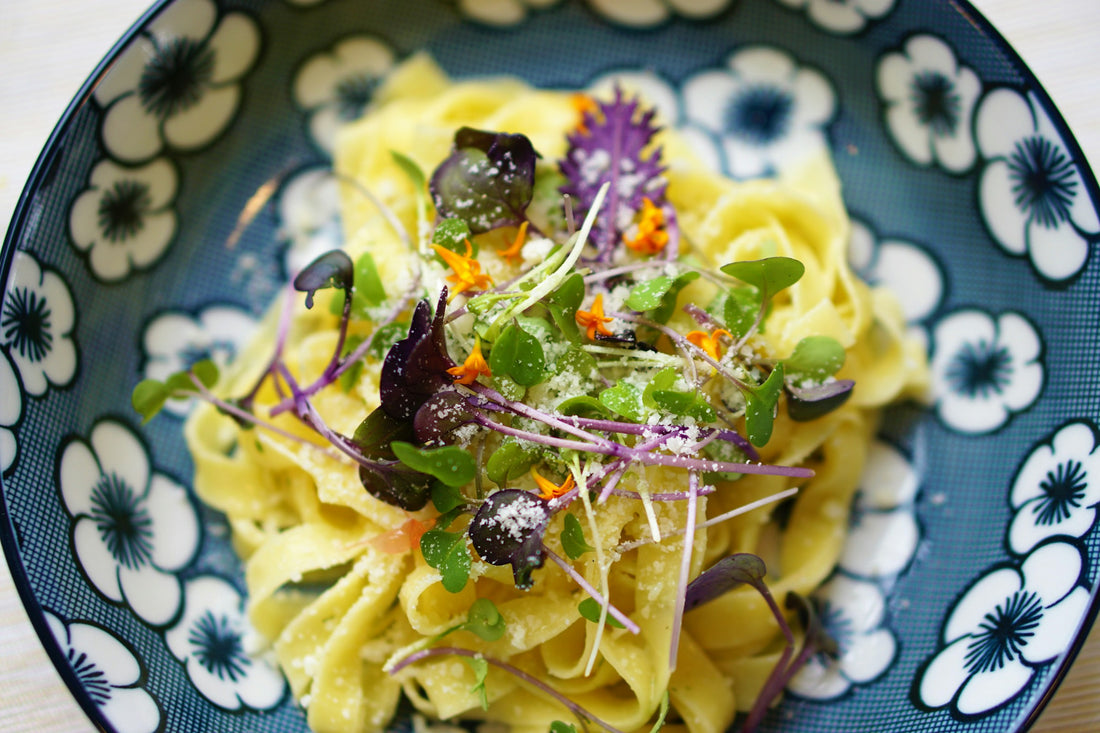
3 Easy Meals Using Fresh, Homegrown Produce From Your Garden
Share
Now that you know the incredible health and wellness benefits of home gardening, it’s time to explore ways to make use of that fresh, homegrown produce from your garden. These creative recipes feature some of the most popular, beginner-friendly plants and herbs that home gardeners like to start with — and are bursting with flavor, nutrients, and antioxidants.
The Most Nutritious Homegrown Produce For Beginner Gardeners
Several plants commonly grown at home by beginner gardeners are rich in nutrients and highly nutritious, including:
- Kale: This leafy green is packed with vitamins A, C, and K, as well as calcium, iron, and antioxidants. It’s relatively easy to grow and can thrive in various climates.
- Spinach: Another leafy green, spinach is loaded with vitamins A, C, and K, as well as folate, iron, and calcium. It can be grown in containers or in the ground and is a versatile addition to salads, smoothies, and cooked dishes.
- Tomatoes: Rich in vitamins C and K, as well as potassium and antioxidants like lycopene, tomatoes are the most popular home garden choice, according to Iowa State University. They thrive in pots or in the ground, but require sunlight and well-drained soil.
- Swiss Chard: Swiss chard is high in vitamins A, C, and K, as well as magnesium and iron, and like many other veggies on this list, do well in both an in-ground garden and in a potted garden
- Microgreens: Microgreens, such as broccoli, kale, and radish, are harvested when they are young and tender, making them nutrient-dense. Grow them indoors in trays and get ready to harvest in just a few weeks.
- Herbs: Many herbs, such as basil, parsley, and cilantro, are not only flavorful but also nutritious, containing vitamins, minerals, and antioxidants. They’re perfect for an outdoor garden but do equally well in pots on your kitchen windowsill!
BREAKFAST: Sweet Spinach Smoothie
“Spinach is rich in iron, vitamin C and E, potassium, and magnesium,” report various doctors. “As part of a nutritious diet, it can help support immune function, aid the digestive system, may even have anticancer properties.”
Get your day off to a strong start with homegrown produce like spinach. There’s no better way to start your day, and the addition of antioxidant-rich fruit, plus protein and probiotics from yogurt, makes this a superfood breakfast.
1 cup fresh spinach leaves, washed
1 ripe banana, peeled and sliced
1/2 cup frozen mixed berries (such as strawberries, blueberries, raspberries)
1/2 cup Greek yogurt (plain or vanilla flavored)
1/2 cup milk (dairy or non-dairy alternative like almond milk, soy milk)
1 tablespoon honey or maple syrup (optional, for added sweetness)
1/2 teaspoon vanilla extract (optional, for flavor)
Wash the spinach leaves thoroughly under cold water to remove any dirt or debris. Pat them dry with a paper towel.
In a blender, combine the spinach leaves, sliced banana, frozen mixed berries, Greek yogurt, milk, honey or maple syrup (if using), and vanilla extract (if using).
Blend the ingredients on high speed until smooth and creamy. If the mixture is too thick, you can add a little more milk to reach your desired consistency.
Taste the smoothie and adjust the sweetness if necessary by adding more honey or maple syrup.
Once the smoothie is well blended and smooth, pour it into glasses and serve immediately. Optionally, you can garnish with additional fresh berries or a sprig of mint for a decorative touch.
LUNCH: Easy Microgreens Salad
“Growing microgreens at home can be a fun and easy hobby,” explains the University of California. “The big difference between microgreens and sprouts is that microgreens have developed the first 2 true leaves of the plant, called cotelydons, whereas sprouts haven’t developed leaves yet and often have the seed attached.”
This type of homegrown produce is a great option for those of us without outdoor gardens. They’re also highly nutritious and are easy to grow (PennState Extension has an easy tutorial on how to start with this type of homegrown produce in your own kitchen). Despite their small size, microgreens are packed with vitamins, minerals, and antioxidants. Studies have shown that microgreens can contain higher concentrations of certain nutrients compared to their mature counterparts. That’s because microgreens are harvested at an early stage of growth, typically when they are just a few inches tall. At this stage, they contain concentrated levels of vitamins, minerals, and phytonutrients.
Microgreens come in a variety of flavors, textures, and colors, making them versatile ingredients that can be added to salads, sandwiches, wraps, smoothies, and more. This recipe turns this versatile homegrown produce into an antioxidant-rich, immunity-boosting, and protein-rich salad.
2 cups of mixed microgreens (such as arugula, kale, radish, or pea shoots)
1 cup cherry tomatoes, halved
1/2 cucumber, sliced
1/4 red onion, thinly sliced
1/4 cup crumbled feta cheese
1/4 cup toasted nuts or seeds (such as almonds, walnuts, or pumpkin seeds)
2 tablespoons extra virgin olive oil
1 tablespoon balsamic vinegar
Salt and pepper to taste
Rinse the microgreens thoroughly under cold water and pat them dry with a paper towel. Place them in a large salad bowl.
Add the halved cherry tomatoes, sliced cucumber, thinly sliced red onion, crumbled feta cheese, and toasted nuts or seeds to the bowl with the microgreens.
In a small bowl, whisk together the extra virgin olive oil and balsamic vinegar to make the dressing. Season with salt and pepper to taste.
Drizzle the dressing over the salad ingredients in the bowl.
Gently toss the salad until all the ingredients are evenly coated with the dressing.
Taste the salad and adjust the seasoning if necessary with additional salt and pepper.
Once the salad is well mixed and seasoned to your liking, divide it among serving plates or bowls.
Serve the microgreens salad immediately as a nutritious and refreshing side dish or light meal. Enjoy your vibrant and flavorful microgreens salad!
DINNER: Swiss Chard and White Bean Pasta
“Although kale is often deemed the king of greens, Swiss chard is equally impressive for its wide array of nutritional benefits,” explain registered dietitian Jillian Kubala. “Dark, leafy green vegetables are among the most nutrient-dense foods. The leaves and stalks of Swiss chard, in particular, provide an abundance of vitamins, minerals, and powerful plant compounds.”
This delicious dinner recipe featuring Swiss chard is perfect for a cozy weekday dinner because it’s flavorful, healthy, stars your hard-earned homegrown produce, and takes just minutes to prepare.
8 ounces pasta (such as penne or fusilli)
1 bunch Swiss chard, washed and chopped
2 tablespoons olive oil
3 cloves garlic, minced
1 can (15 ounces) white beans (such as cannellini beans), drained and rinsed
1/4 teaspoon red pepper flakes (optional)
Salt and black pepper to taste
Juice of 1/2 lemon
Grated Parmesan cheese for serving (optional)
Cook the pasta according to package instructions until al dente. Drain and set aside, reserving 1/2 cup of pasta cooking water.
While the pasta is cooking, heat the olive oil in a large skillet over medium heat. Add the minced garlic and cook for 1-2 minutes until fragrant.
Add the chopped Swiss chard to the skillet and cook, stirring occasionally, until wilted, about 3-4 minutes.
Stir in the white beans and red pepper flakes (if using). Season with salt and black pepper to taste.
Add the cooked pasta to the skillet along with the reserved pasta cooking water. Stir well to combine and cook for an additional 2-3 minutes until heated through.
Squeeze the lemon juice over the pasta and Swiss chard mixture, tossing to combine.
Taste and adjust seasoning if necessary.
Serve the Swiss chard and white bean pasta hot, garnished with grated Parmesan cheese if desired. Enjoy your flavorful and nutritious pasta made with your own homegrown produce!
